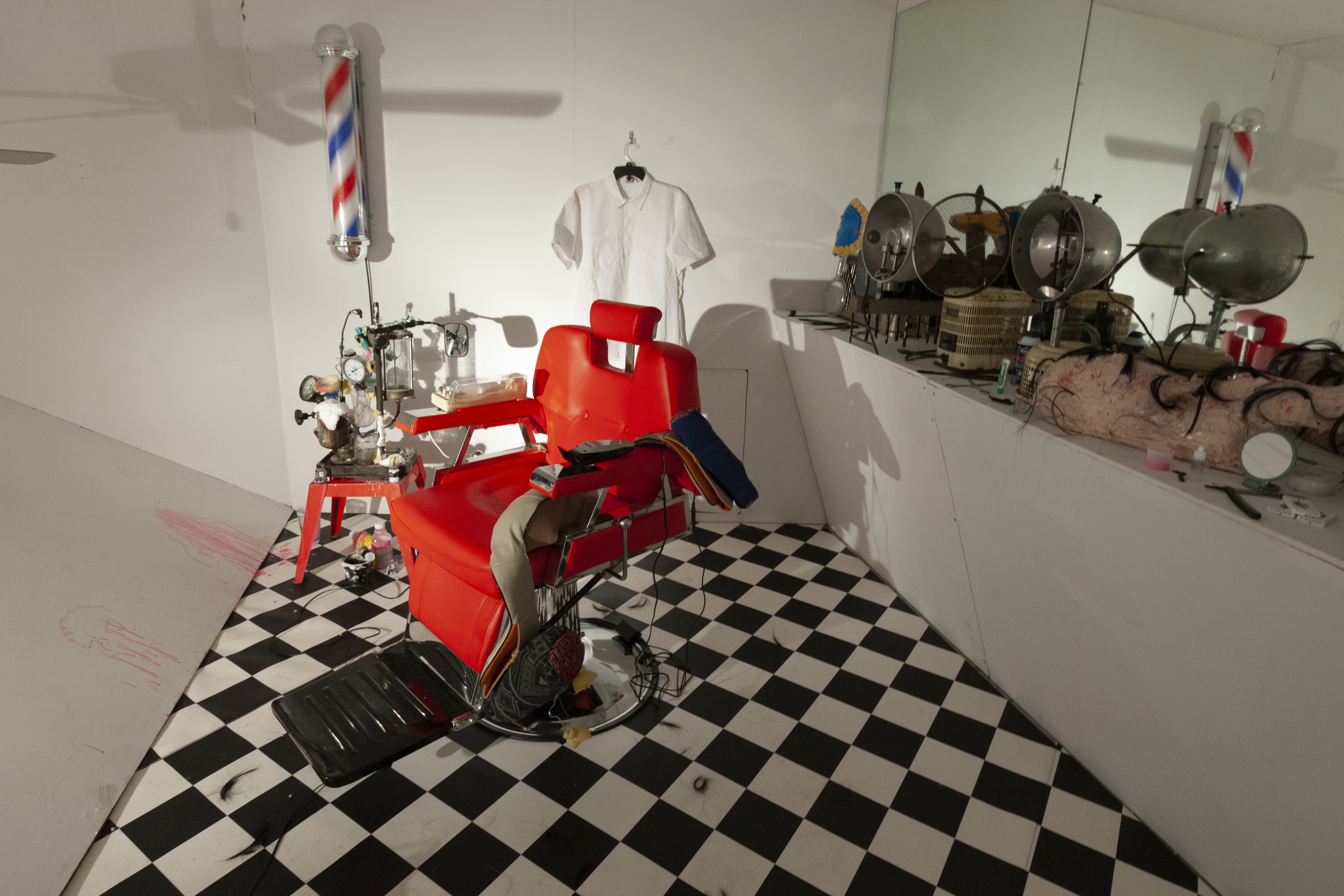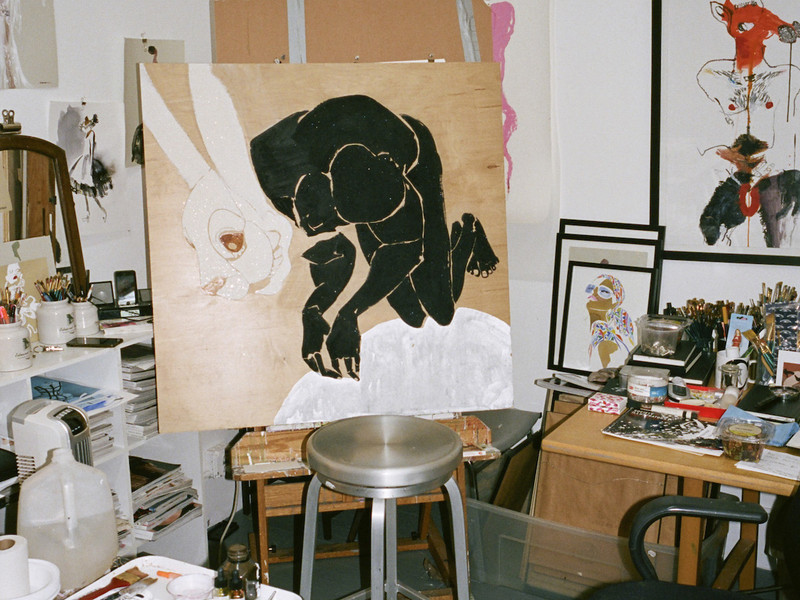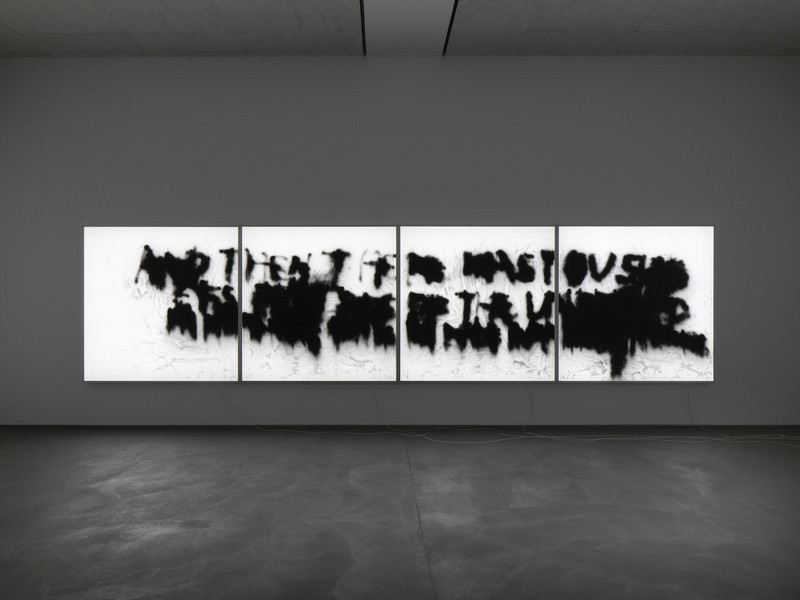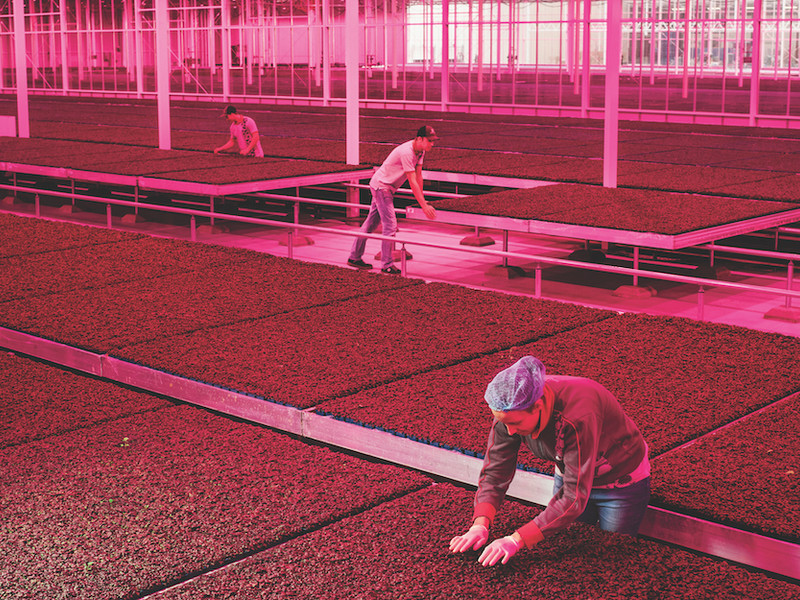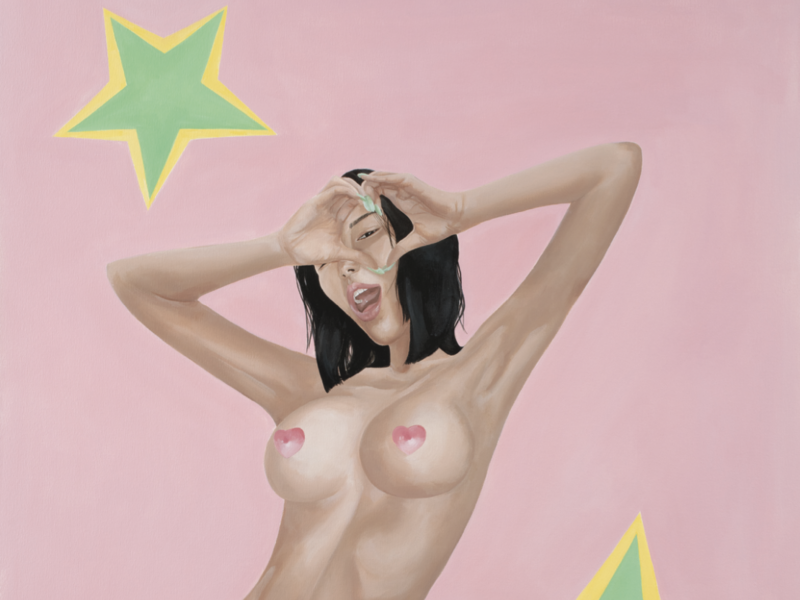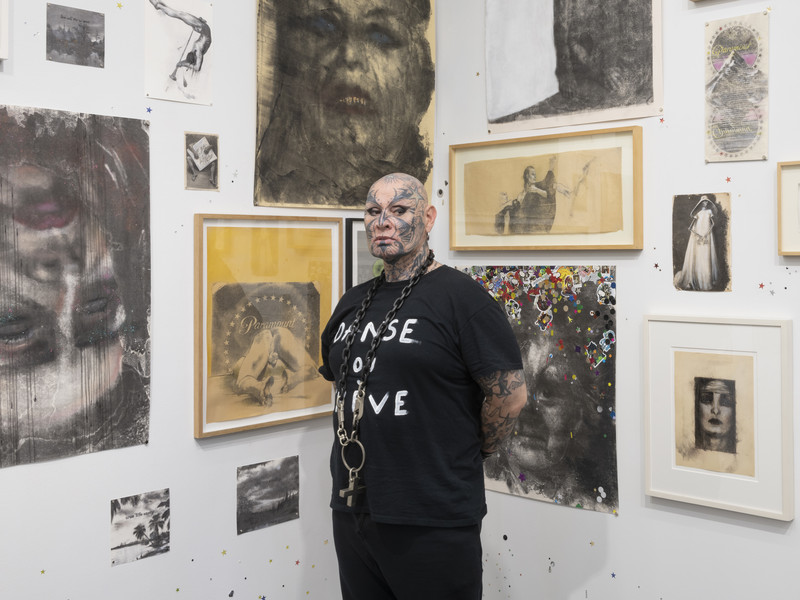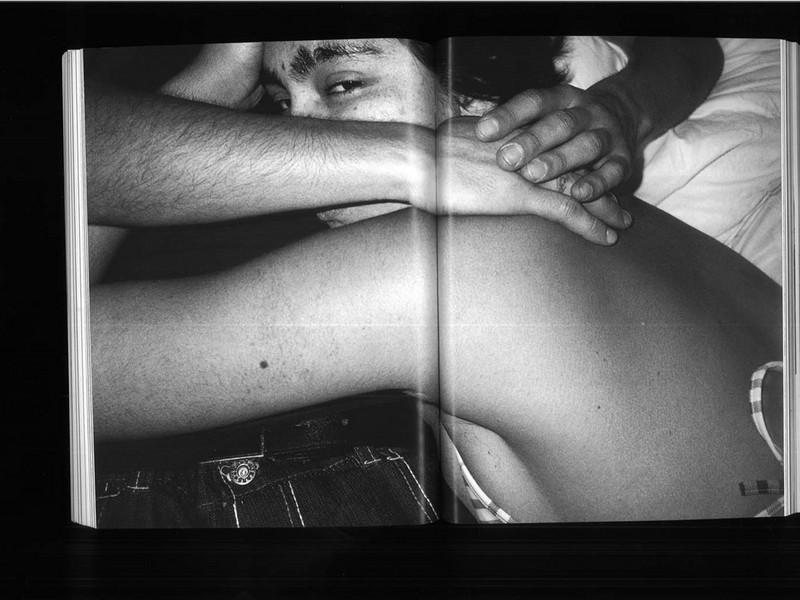Dead + Juicy
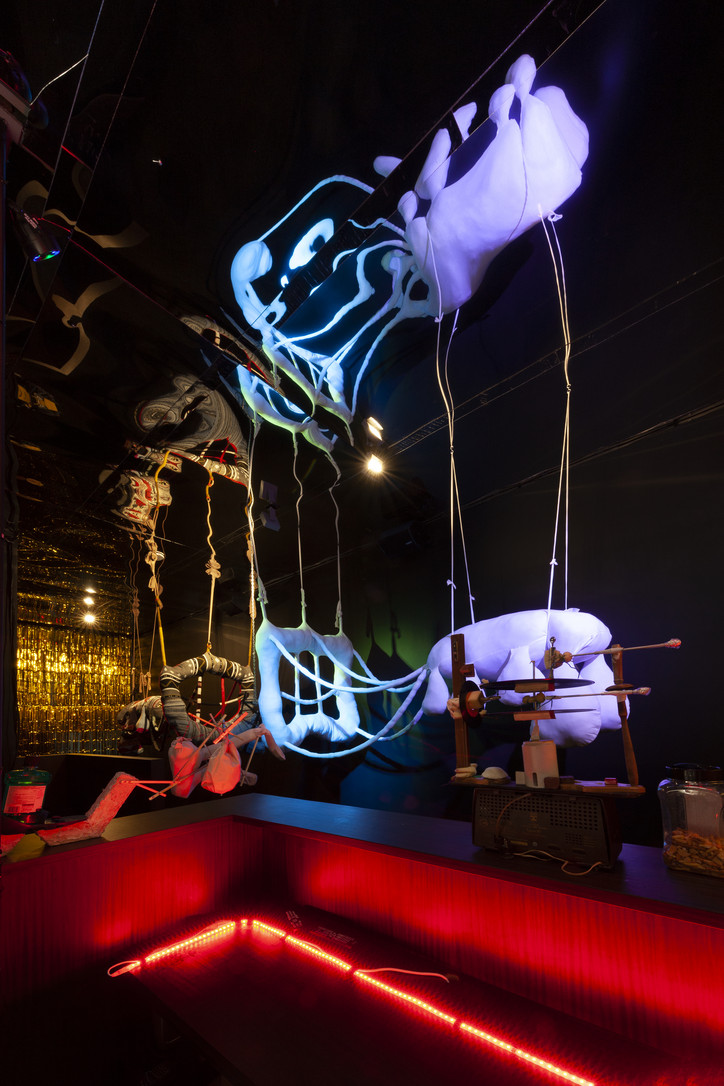
office met with John Bock the day after the opening to talk about barber shops in Austin, Texas, the fleeting nature of desire and the fact that you can use anything as a medium—even Pepto-Bismol.
Tell me about your horror musical.
It’s true—it’s a horror musical. I did it for a museum in Austin—The Contemporary—and we shot the film in four days. In the end, it was 60 minutes long. The story is about an uncanny barber shop with all different kinds of people. Everything they do is abnormal—they tell stories and sometimes, they do different things with uncanny objects, then they sing. It was mostly improvised—I asked them what they like, and one of them said they like funk, or whatever band, so I'd have them sing a funk song and a song by that band. The Spanish guy was a great moment—suddenly, he said he was a singer and could play the harmonica, and it just went from there.
So, a big part of the process was that it came from Austin and the people there?
Yeah, I took an Austin barber shop and made it uncanny. The lead character disappears in a time warp into a hut, then a jungle, then suddenly, she stands in front of her own little apartment and looks in, and she sees herself. There’s the twist. What I liked most was the time in the barber shop—it’s kind of magical, they wait there and they switch off the brain and try to relax. It’s Americana, but it’s also a ritual. I thought, 'What happens when they’re there all the time?' Each day, they go to the barber shop, and they’re with each every day, with all the same guests in this same shop, and they don’t even cut their hair. They do other things though, little miracles and rituals. Then they’re singing. It’s a little bit like a '70s sitcom or a soap opera—like, All in the Family.
How did you decide on a barber shop?
We relax in a barber shop. It’s different than a coffee shop—everyone knows a coffee shop—but a barber shop is more for males, for shaving; a woman goes to a salon. I like this atmosphere where the guys are there, their shaving, cutting their hair. It’s a man’s world, but I was drawn to it, I don’t know why.
Right. But then the lead character is female.
It’s also a little erotic—this young girl and these old guys. But also, I wanted to incorporate different ethnicities—Mexican, black, white. But this is Texas. First, I looked at the faces.
What about the faces?
Oh, they look very good, right? You can tell something from them—the faces tell stories. It’s very easy to shoot animals, and to shoot old men and women because their face speaks in the so-called wrong way. They have so much experience—that's why I don’t understand why Americans get facelifts and all of that.
I was just talking about plastic surgery with another artist.
Yeah, it’s just, why? The thing is, your face is like a painting and it changes, but it’s the best thing you have. Normally, when you have a car, you keep it—only when you crash it do you need a new one. But with a face—it’s crazy.
I overheard some talk about cycles and I noticed a lot of spinning in the video.
And doubles. In the exhibition, there are pairs—two plates, two silicone creature objects in the barbershop—they are like twins, mirrors. And then I built not only one object, but two—and they come together.
How does the performance play into that?
This was a big improvisation, and it was the first time I’d done it. Normally, I work with a script, and learn text, then recite it. But in this case, I wanted only to be there and do something.
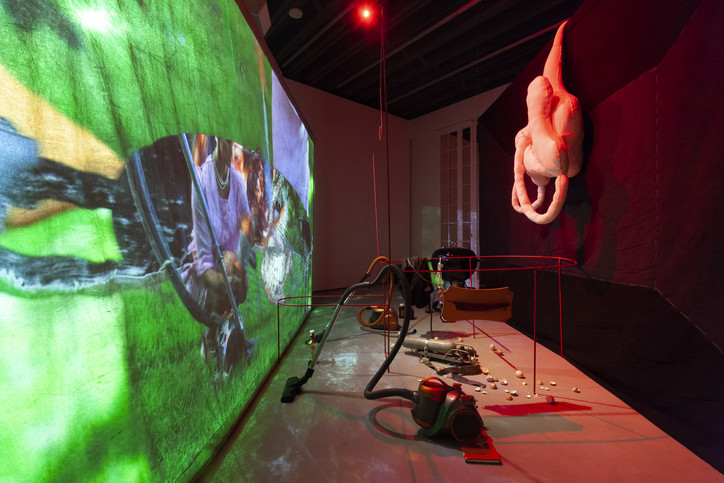
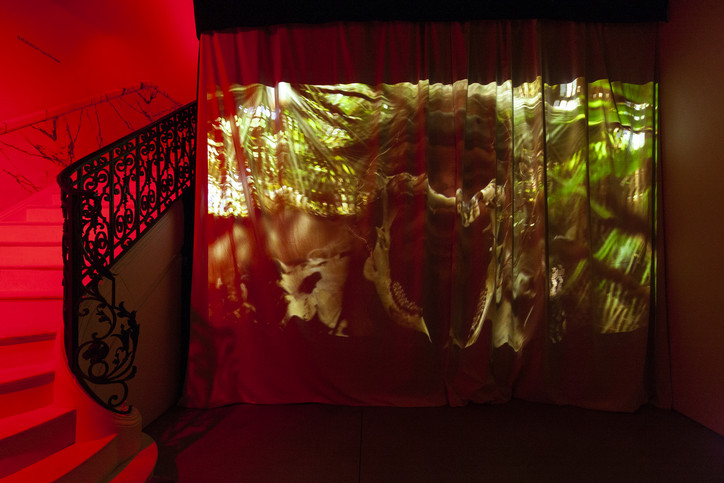
Why improvisation?
I don’t really know why I did this. It was the first time.
How do you feel about the result?
It was very new. In the beginning, I was wondering what I should do, but then I looked around at the objects and it came step by step. But the beginning was very difficult. I started with reading text and didn’t like that, so I used some objects—I worked with wigs, then later with shaving cream, then the machine.
It was really fun to watch you play with the materials. Why do you think you’re so attracted to these gooey things like shaving cream?
It disappears. Normally you fix everything, you build it in a frame, it’s a figure. Shaving cream—nobody cares about shaving cream—it’s not necessary to preserve it. The other point is the fear of these art objects. When I look at art, I feel fear because it’s art, because it’s expensive, it means something, it’s in a frame. When I work with shaving cream, or toothpaste, or liquids, then they have no detailed shape. And people don’t think about the shape with these materials. With traditional painting, you’re always thinking about shape, but when you work with liquids, you have no control over it, it flows, and people don’t want shaving cream to be in a shape.
Right. It doesn’t matter.
This is the language: it doesn’t matter. It disappears. They don’t think about the shape, they think about the material. And this is a different way to look at the world—instead of preserving everything, following the rules, speaking the right words, this is different. Art is a language—a different language than our language—and this is good, because our language is political. They check everything that you say, you can’t write without a certain shape to it—but I can. Art can say something that is not so directly political—it can talk about a sugar cube and it means a sugar cube, not a ‘white’ sugar cube, you know what I mean? So, it’s a different language that’s able to speak in many directions—it’s not physical, it’s not systemic, it’s not economic, it’s not political, it’s different. It’s political when the art is very expensive and society is interested in money, getting it, saving it, selling it. Then, it’s like a car.
Your work isn’t necessarily within that context.
It’s also difficult to buy this stuff. How can you buy art made out of shaving cream, or Pepto-Bismol? And the smell? Pepto-Bismol smells almost like candy—it’s so sweet, and it’s pink, and I handle it and you see it. But there’s no frame.
It’s kind of like something you have to experience, but that’s all that you get—the experience—then it vanishes.
But there’s also the movie—then there’s a frame, you edit it, there’s a soundtrack, you create a product. But the performance is less of a product.
So, you’re interested in this lack of control, or letting control go. It's almost like—not chaos—but something else. Maybe randomness?
Entropy, yeah. It’s like in a library—everything is in the right order, but some people say, 'No, I like this book, I don’t want to put it in M, I want to put it in B,' or 'I don’t want to put it in Art but in Politics, because nobody should see it.' Something happens in that moment.
I wanted to talk about the sculptures, as well. I love the idea of bringing something from a film into real life—I’ve seen it one other time, and it’s so interesting.
It’s very easy. When I studied art, I didn’t like to build the objects in the studio, and that’s it. Then you have to bring it in the closet, make another one, then wait for the art dealer. I said very early, 'No, the best is to do a performance and create the objects directly in front of the audience.' So, I used these kinds of cheap, secondhand materials, so the audience has no fear of the objects, because they have no larger value. Then I would do performances and combine this with language. Normally, the performances in the '70s and '80s, and also now—it’s always about pathos.
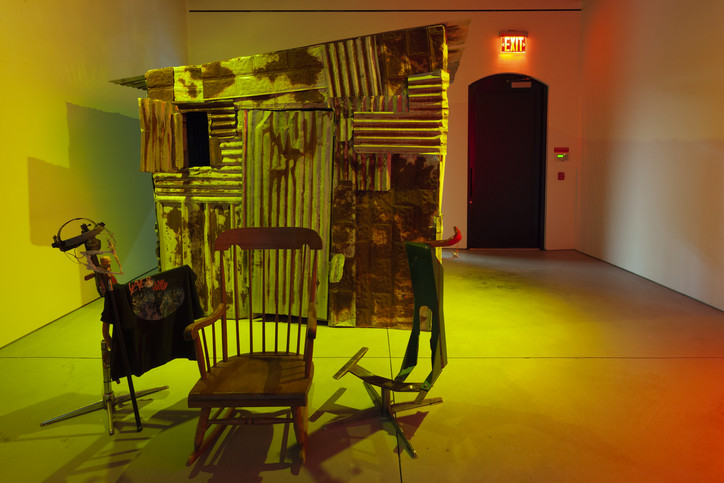
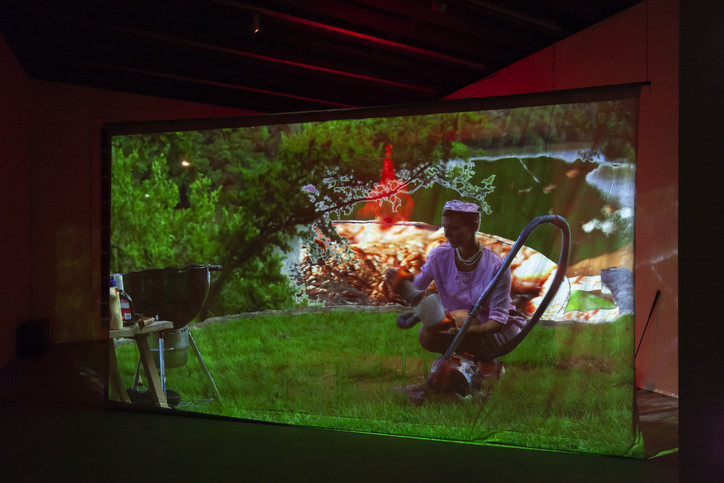
It feels like you’re breaking the fourth wall in a lot of ways—pulling people into the piece.
To me, it’s important what people see and what happens with them, not how I create the object, which material, or which technique. When I find that I have a technique, then I destroy it—that’s important. You perfect a technique and things get better and better, but the energy is lost. And when you do things, and you’re not a professional, it’s more charming. Like Jack Smith’s movies, for example—like Flaming Creatures from the '60s.
Have you ever thought about doing a professional film for a broad audience outside the category of art?
I did movies, but I didn’t show them at film festivals.
What about something more traditional?
Well, this is traditional. There’s a narrative, the editing is normal. But in the installations, they are collages, there’s more intention, they’re more expressive, you can’t explain what’s happening. The pictures come in layers. There’s a game between the object and the projection—suddenly the original object is a part of the movie. Downstairs, there’s a projection where nothing happens—it shows a space and nothing happens, and it’s across from the barber shop we built in the gallery, which is a real space.
So, they’re both spaces that aren’t moving, but one is physical, and one is an image.
And in this little flat there are objects: the bike, a rat, the two plates—always double. The character in the film creates sculptures from tinfoil TV dinner trays, and these objects are in front of the projection. So, it’s like a mirror. One is a video projection, the other side is a shadow. It’s about the possibilities of how to show something. In the movie, they do something, but in the installation, they do the same things and suddenly it’s different. I tell the story in different ways: in a normal narrative way, and then through the installation.
It’s like you’re adding layers but also removing them at the same time—or inviting the viewer to become a layer.
You can go around the screen and suddenly you see the objects. Things mutate. When you first enter the gallery, you see a projection on a curtain and when the curtain moves, the image mutates. So, there’s this idea of mutation and change. It’s a play with pictures and how you look at it—the point of view.
It reminds me of the part of the film where the main character’s describing some strange thing growing inside of her. It feels very psychological.
Most people want to buy a car—they’re interested in buying things. I’m interested in people’s brains, they’re stories. And it’s funny—when you buy something, you desire it until you have it. Once you own something, the desire for it disappears, and it becomes just another object.
So, it’s about economics in a way.
It’s about economics and how people exist within economics. I don’t think people are very happy with this system. We think it’s normal, but inside we feel weird. In the barber shop in the film, there is no money—they tell stories and sing. It’s about a connection between people in one space, and not always glued to your phone like people always are these days, even in Germany.
Right. They’re engaged.
It’s like a dreamland—a paradise. No one knows about it. It’s old guys, in an old style. And my language is more absurd in German than in English. I don’t believe in language; I actually hate it—that's why I work with it. There are a lot of mistakes and levels with language, and I want to break it down entirely.
'Dead + Juicy' is open now through December 1 at Anton Kern Gallery in NYC.
Photos courtesy of Anton Kern Gallery.



